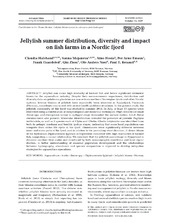| dc.contributor.author | Halsband, Claudia | |
| dc.contributor.author | Majaneva, Sanna Kristiina | |
| dc.contributor.author | Hosia, Aino | |
| dc.contributor.author | Emaus, Per | |
| dc.contributor.author | Gaardsted, Frank | |
| dc.contributor.author | Zhou, Qin | |
| dc.contributor.author | Nøst, Ole Anders | |
| dc.contributor.author | Renaud, Paul Eric | |
| dc.date.accessioned | 2018-02-09T09:24:06Z | |
| dc.date.available | 2018-02-09T09:24:06Z | |
| dc.date.issued | 2017 | |
| dc.Published | Halsband C, Majaneva SK, Hosia A, Emaus P, Gaardsted F, Zhou Q, Nøst OA, Renaud P. Jellyfish summer distribution, diversity and impact on fish farms in a Nordic fjord. Marine Ecology Progress Series. 2017 | eng |
| dc.identifier.issn | 0171-8630 | |
| dc.identifier.issn | 1616-1599 | |
| dc.identifier.uri | https://hdl.handle.net/1956/17365 | |
| dc.description.abstract | Jellyfish can cause high mortality of farmed fish and hence significant economic losses for the aquaculture industry. Despite their socio-economic importance, distribution and diversity data on gelatinous plankton are scarce from northern Norwegian fjords and other Nordic systems. Intense blooms of jellyfish have repeatedly been observed in Ryggefjord, Finnmark (Norway), sometimes concurrent with severe health problems of salmon. In the present study, the jellyfish community of this fjord was studied in summer 2015. In July, at least 13 species were identified using a combination of morphological and molecular techniques. High densities of small Beroe spp. and ctenophore larvae in cydippid stage dominated the surface waters. Adult Beroe cucumis were also present. Molecular identification revealed the presence of juvenile Euphysa tentaculata, as well as 2 species each of Clytia and Obelia. Obelia longissima was identified from both its pelagic (medusa) and benthic (polyp) stages, indicating that some local populations can complete their entire life cycle in the fjord. Abundances were significantly different between inner and outer parts of the fjord, and in relation to the prevailing wind direction. A dense bloom of the hydrozoan Dipleurosoma typicum in September coincided with high mortalities of farmed fish, suggesting a causal relationship. We conclude that the jellyfish assemblage in Ryggefjord is dynamic on short time scales and structured by both oceanographic conditions and local reproduction. A better understanding of seasonal population development and the relationships between hydrography, abundance and species composition is required to develop mitigation strategies for aquaculture operations | en_US |
| dc.language.iso | eng | eng |
| dc.publisher | Inter-Research | eng |
| dc.relation.uri | http://www.int-res.com/articles/theme/AdvanceView/M12274_Halsband_JB5.pdf | |
| dc.rights | Attribution CC BY | eng |
| dc.rights.uri | http://creativecommons.org/licenses/by/4.0 | eng |
| dc.subject | Aquaculture | eng |
| dc.subject | Arctic | eng |
| dc.subject | Beroe spp. | eng |
| dc.subject | Dipleurosoma typicum | eng |
| dc.subject | Jellyfish bloom | eng |
| dc.subject | Norway | eng |
| dc.title | Jellyfish summer distribution, diversity and impact on fish farms in a Nordic fjord | eng |
| dc.type | Peer reviewed | en_US |
| dc.type | Journal article | en_US |
| dc.date.updated | 2018-02-05T09:43:10Z | |
| dc.description.version | publishedVersion | |
| dc.rights.holder | Copyright 2017 The Author(s) | eng |
| dc.identifier.doi | https://doi.org/10.3354/meps12274 | |
| dc.identifier.cristin | 1558068 | |
| dc.source.journal | Marine Ecology Progress Series | |
| dc.relation.project | Norges forskningsråd: 548990 | |

